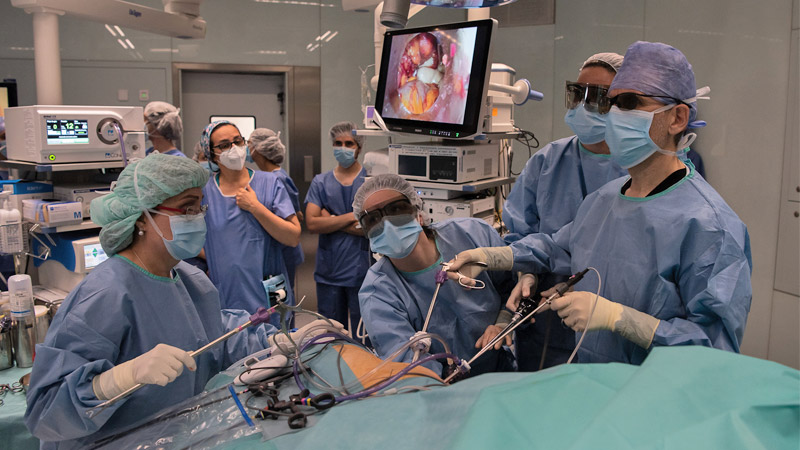20 May, 2021
Hospital Clínic is the first Spanish centre to perform 1,000 living donor kidney transplants

The Hospital Clínic is a reference centre in Spain when it comes to kidney transplants. On July 27, 1965, doctors Josep María Gil-Verat and Antoni Caralps completed the first kidney transplant in Spain. In all the time that has elapsed since then, 5,000 transplant operations have been carried out in the centre, of which 1,000 have been from a living donor, being the first centre in our country to achieve this figure. Some numbers that undoubtedly serve to highlight the transcendental role that the centre plays in our country with regard to kidney transplants.
Living donor, the best option for kidney transplantation
In Spain, about 68,000 interventions of this type have been carried out and the vast majority, some 63,000, have used organs from dead donors. A little more than 4,700 have been performed from living donors, the Hospital Clinic being one of the main centres in this regard, being responsible for just over 21% of these living donor transplants. “Living donor transplantation is the best therapeutic alternative for chronic kidney failure, but each operation is a challenge. It must be approached with transparency and objectivity, with knowledge”, explains Dr Josep Maria Campistol, nephrologist and director of the Hospital Clínic.
Therefore, in our country there is a guarantee system that seeks above all to eliminate any doubt about the altruistic act of donating a kidney. Donors must pass three different filters before starting the whole process. First, pass a medical and psychosocial interview with the professionals of the transplant circuit, then receive the endorsement of the hospital’s ethics committee and finally sign an affidavit before the judge that their decision is informed and free.
Living donor kidney transplantation has certain advantages, with minimal or almost no sequelae for both the recipient and the donor, which is why it is increasingly the preferred option. “97% of these transplanted kidneys function per year and it is without a doubt a success story. Donor recovery is very fast and in just three days they can go home. The recipient has to stay a little longer, but this has also been reduced in recent years”, says Dr Antonio Alcaraz, urologist and surgeon at barnaclínic+ and Head of the Urology and Kidney Transplant Service at Hospital Clínic, responsible for almost two-thirds of the 1,000 transplants performed at the centre.
“97% of these transplanted kidneys function per year and it is without a doubt a success story. Donor recovery is very fast and in just three days they can go home. The recipient has to stay a little longer, but this has also been reduced in recent years”
Dr Antonio Alcaraz, urologist and surgeon at barnaclínic+ and Head of the Urology and Kidney Transplant Service at Hospital Clínic
New approaches to kidney transplantation: robotic surgery
More than fifty years doing this type of intervention have served to achieve a high degree of excellence. In addition, the Hospital Clínic in all that time has not stopped innovating, and in recent times it has incorporated robotic kidney transplantation surgery, an approach that offers great advantages reducing complications, preventing abdominal wall infections, and increasing success rates.
IT MAY INTEREST YOU…
· The Hospital Clínic Group, pioneer and leader in robotic surgery
Changes in patient profiles
The goal of kidney transplantation is to restore the functions of the organ when it is so damaged that it is no longer able to function. These include the purification of toxins from the blood, the balance between the amount of water and minerals in the body or producing the synthesis of certain hormones.
Kidney disease usually occurs in the elderly, over 70 years of age. However, in recent years some changes are taking place and it is increasingly common to see younger patients, aged between 55 and 60 years, in which diabetes is the main cause of kidney failure.
The kidney transplant process
When considering a living donor transplant, the closest possible age similarity with the donor is sought, with couples being a good option. But in younger patients, parents or even grandparents may also be suitable donors. In any case, the entire process begins with a medical review of the donor, a complete analysis that includes serology and blood group and imaging tests with which to study the anatomy of the kidney to be transplanted.
When it comes to selecting the kidney, the preference is usually the left kidney. This is because it allows a longer vein to be obtained, which later facilitates surgery. However, if there were any abnormalities in this left kidney, the right could always be removed. Another issue that is valued when choosing the organ is that it is preferred that it have unique vessels. The kidney consists of a renal artery originating in the abdominal aorta, but it is not unusual to find organs with arterial or renal variations. Although there is multiple irrigation, the organ is also considered valid.
To carry out the intervention, a laparoscopy is performed. This consists of small incisions in the abdomen, into which plastic tubes or trocars are introduced, and through these the instrumentation is introduced into the patient. Once the kidney has been dissected, the renal arteries and veins are sealed using clips. The removal of the organ can be through an incision on the navel or lower abdomen or, in the case of women, through an incision in the vaginal vault. Once this procedure is completed, the kidney is prepared for immediate implant.
1,000 living donor transplants at Hospital Clínic
Below is a brief chronology of the 1,000 living donor transplants at Hospital Clínic Barcelona.
- 1965 – The 1st transplant. The Clínic is the first centre in Spain to perform a kidney transplant. The team of Dr Josep M. Gil-Vernet, with the collaboration of the nephrologist Antoni Caralps, performed the first kidney transplant in July 1965. The first living donor transplant was in October
- 1971 – The 1st living donor transplant to a minor
- 1977 – The 1st living donor transplant to a diabetic patient
- 1978 – The 100th living donor transplant is performed
- 1999 – The 1st living donor transplant between spouses
- 2002 – The 1st laparoscopic nephrectomy
- 2006 – The 1st living donor transplant between two incompatible people (blood group)
- 2006 – The 1st living donor transplant to a person older than 70 years
- 2009 – The 1st living donor crossover transplant (with the Virgen de las Nieves Hospital- Seville)
- 2010 – The 500th living donor transplant is performed
- 2010 – The 1st living donor transplant is performed at barnaclínic+
- 2015 – The 1st robotic living donor transplant
- 2021 – The 1,000th living donor transplant is performed


